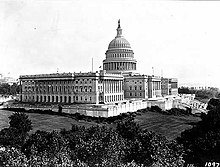72nd United States Congress
| 72nd United States Congress | |
|---|---|
|
71st ←
→ 73rd
|
|

United States Capitol (1906)
|
|
| March 4, 1931 – March 4, 1933 | |
| Senate President | Charles Curtis (R) |
| Senate Pres. pro tem | George H. Moses (R) |
| House Speaker | John N. Garner (D) |
| Members | 96 Senators 435 Representatives 5 Non-voting members |
| Senate Majority | Republican |
| House Majority | Democratic |
| Sessions | |
|
1st: December 7, 1931 – July 16, 1932 2nd: December 2, 1932 – March 3, 1933 |
|
The Seventy-second United States Congress was a meeting of the legislative branch of the United States federal government, consisting of the United States Senate and the United States House of Representatives. It met in Washington, D.C. from March 4, 1931 to March 4, 1933, during the last two years of Herbert C. Hoover's presidency. The apportionment of seats in this House of Representatives was based on the Thirteenth Decennial Census of the United States in 1910. The Senate had a Republican majority, and the House had a Democratic majority.
The count below identifies party affiliations at the beginning of the first session of this Congress, and includes members from vacancies and newly admitted states, when they were first seated. Changes resulting from subsequent replacements are shown below in the "Changes in membership" section.
Republican Nicholas Longworth had served as Speaker in the previous Congress. He would have been re-elected as Speaker in this Congress had the House convened in March 1931, when Republicans had a tiny 3-seat majority. By December 7, 1931, when the first session of the Congress began, Democrats gained enough seats through deaths and special elections to take control and elect one of their own as Speaker. Longworth himself died on April 9, 1931, during this time between the beginning of the Congress and its first session.
This list is arranged by chamber, then by state. Senators are listed by class, and Representatives are listed by district.
Senators were elected every two years, with one-third beginning new six-year terms with each Congress. Preceding the names in the list below are Senate class numbers, which indicate the cycle of their election. In this Congress, Class 1 meant their term began in the last Congress, requiring reelection in 1934; Class 2 meant their term began with this Congress, requiring reelection in 1936; and Class 3 meant their term ended with this Congress, requiring reelection in 1932.
...
Wikipedia
